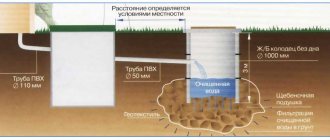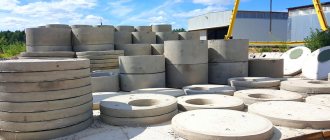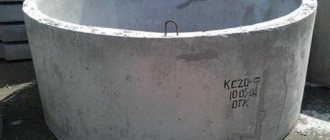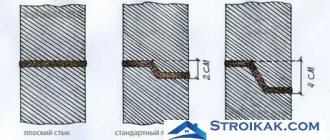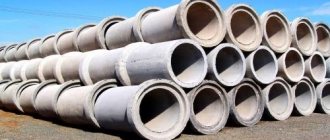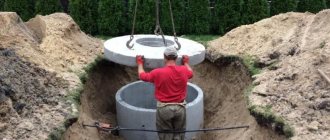The volume of a concrete ring is the quantity that is needed to calculate the optimal dimensions of the product during the design and installation of a particular system or well. Concrete rings are used everywhere today, serving as the main elements in the installation of various types of wells (sewage, water supply, inspection, gas, etc.).
Rings are selected in accordance with the requirements for weight, internal diameter, height. All important characteristics are specified in the product labeling. All concrete products of this type are produced in accordance with GOST 8020-90, using high-quality concrete and steel reinforcement. Thanks to this, concrete rings are strong and reliable, resistant to aggressive environments and mechanical loads, durable and resistant to moisture.
The installation of a well and sewerage system may be needed in a variety of cases; it is relevant both for multi-storey buildings and for private housing construction. Structures are subject to certain requirements for strength, sanitary and hygienic standards, volume, etc. And all the important properties of a well can be ensured by the use of high-quality and suitable-sized concrete rings, covers, support rings, bottoms and all structural elements.
Types of concrete well rings
Concrete rings are used in the construction of wells for various purposes. Drinking, sewer, waste columns, settling tanks, and reservoirs are collected from them. They are also used to build sewer settling tanks and septic tanks. GOST 8020-90 defines all types of products for the manufacture of networks and wells in particular. Not all of them are used in everyday life. The most commonly used types of rings are:
- KS - wall or through ring. It is a concrete cylinder. Installed one on top of the other, they form a well column. They come in different diameters - from 70 cm to 200 cm, with a wall thickness from 5 to 10 cm. They can be: ordinary with a smooth edge, standard wall thickness;
- with a formed projection - for a locking joint;
Concrete rings for the walls of wells can have a seam edge - this is when a protrusion is formed for the locking connection - reinforced - with a large wall thickness for deep cases;
- reinforced - with inserted reinforcement.
According to the standard, the walls of the rings can have a technological slope of no more than 1.5%. But at the same time, the wall thickness and internal diameter at the middle of the height must coincide with the standard ones. In general, smooth walls, the absence of cavities and cracks are a sign of normal quality.
Advantages and disadvantages
Reinforced concrete structures have long occupied a leading position in the building materials market, but even when using them, the buyer must be prepared to encounter some difficulties. When compared with similar products made from other materials (plastic, polymer mixtures), undeniable advantages can be identified:
- suitability for all types of structures;
- affordability of prices;
- large selection of size models;
- durability and strength ensured by the use of heavy reinforced concrete grades 200-500;
- rigidity of the structure, which can also be installed on unstable soils;
- simplicity and speed of installation;
- the ability to produce components on site with your own hands;
- reliable protection against seasonal swelling of the soil and against entry into the groundwater system.
Reinforced concrete structures.
Disadvantages include:
- transportation difficulties;
- dimensions and weight, which require the use of special equipment during installation;
- lack of mobility (it is extremely difficult to move an installed well).
However, these difficulties do not affect the popularity of concrete rings in any way. Buyers are well aware of both transport and installation costs and are prepared for them in advance.
Marking, dimensions and classification
No matter what the house is, without a sewer system it cannot be called comfortable and modern. Arrangement of engineering systems is a primary task that is solved even before installing the foundation.
Reinforced concrete overflow septic tanks do not lose their relevance, since at a relatively low price they effectively cope with the treatment and collection of wastewater.
Reinforced concrete rings are made by pouring and vibrating in a mold with a certain wall thickness. A steel reinforcing mesh is placed inside the concrete mass, increasing the strength of the product.
Ring types:
- The seam rings, thanks to the locking connections, fit tightly together, which allows for greater tightness in the slop sewer system. This increases the mine's resistance to ground pressure and prevents sewage from seeping into the soil.
- Through sewer rings have a flat end and smooth walls. This is the most inexpensive option for sewerage. During installation, additional measures are required to seal the joints. Typically, cement mortar is used, which further strengthens the structure and increases its resistance to soil pressure.
- Additional rings are products of the same classes, but of smaller height. Their task is to adjust the height of the septic tank to a certain level.
- Filtration rings have through holes (perforations) on their walls. They are used to create filtration wells.
- Shaped products - this group includes all additional structural elements: solid slabs for installation on the bottom of a well, slabs with a hole for installing a sewer cover.
All reinforced concrete products, including shaped ones, have factory markings in accordance with GOST, consisting of alphabetic and digital parts.
Letter marking:
- wall ring - KS;
- floor slab – PP;
- bottom plate - PD.
Digital marking is divided into 2 parts and written with a hyphen. For example, 10-8, where 10 is the internal diameter of the concrete rings for sewerage (in this case 100 cm), and 8 is the height (80 cm).
Some products have slightly rounded values.
More accurate data in tables.
Diameter of concrete rings for sewerage. Dimensions of rings for sewer wells.
In some cases, the manufacturer adds another symbol to the marking, indicating the degree of moisture permeability of the reinforced concrete product:
- N – normal;
- P – reduced;
- O – especially low.
The cover and bottom slabs have a similar marking - 1PP 15. 1 is the load-bearing capacity group, PP is the floor slab, 15 is the outer diameter of the product.
Dimensions of covers for concrete rings:
Bottom plates:
The last number indicates the diameter of the ring to which the lid fits. The slab itself will be 18-20 cm wider.
Floor slabs for reinforced concrete rings for sewerage
Reinforcement
Reinforcement of rings is necessary to increase their service life. Reinforced elements are made using the same vibration pressing method, during which they acquire a more dense structure and become stronger.
In addition, such products have increased water resistance, which allows them to be used for constructing septic tanks that prevent water from entering the ground. The same can be said about groundwater: the tight fit of the component parts to each other eliminates the possibility of the formation of large gaps, and groundwater will not flow into the well source.
How to choose a size
When you have decided on the design of the well, you know what kind of bottom you want, how and with what you will cover the well, the most important thing is to decide on the size of the well. All other elements are of the same size. They are designed to fit one to the other. And the number of links is determined based on the required volume or is approximately calculated based on the depth of the aquifer. For sedimentation tanks, septic tanks, storm wells, they are calculated based on the required storage volume.
The dimensions of well rings of all types must match
If we talk about drinking wells, they are assembled from KS with a diameter of 100 mm (KS-10) to 150 mm (KS-15). A ring with a bottom or a bottom slab is not installed - open access to the aquifer is required. When assembling a well for drainage, a sump tank or a septic tank, it is better to take the lower link immediately with the bottom - both the installation is simpler and the tightness is ensured. Another option is a bottom plate and a KS or KO ring installed on it. KO is placed if there is a need to make the lower part heavier.
Marking, choosing which ones are better to put
Prefabricated reinforced concrete rings for wells are made from Portland cement of a grade not lower than M200. In a factory product, the main dimensions are D1 (external diameter), D2 (internal), H (height). In trade catalogs we find the following standard ring abbreviations:
- KS (wall) – small-diameter products designed to protect networks inside load-bearing walls. Resistant to lateral loads.
- KO (support) - used as a basis for structures and communications.
- KVG - well water-gas parts, due to the possibility of arranging hermetically sealed connections, are recommended for laying communications of the above types.
- KFK are part of a network for the removal and accumulation of feces.
- KLK - thanks to the stability of the material and the strength of the connections, they can withstand heavy loads of the storm drainage system.
The structure will be marked type KS-10-9 (wall, 100 mm wall thickness, 900 mm height).
P (slabs) have standard sizes for arranging bottoms (it has a base) and floors (needed to move from a larger diameter to a smaller one).
Typical internal diameters of concrete links - sizes: 70, 100, 130, 150, 200, 250 cm.
Main characteristics of concrete rings
The use of prefabricated reinforced concrete structures in construction can significantly reduce the time required to complete work, while increasing productivity. It is the rings that are considered the product most often used in construction processes.
Application area
The scope of use of such products can be very different:
- Construction of drinking wells;
- Arrangement of inspection wells necessary to monitor the condition of communication systems;
- Construction of septic tanks;
- Arrangement of storm drainage, etc.
Septic tank diagram
Advantages and disadvantages
The advantages of structures of this kind include:
- High level of strength;
- Durability;
- Frost resistance;
- Easy installation;
- Ease of operation;
- Small price.
But there is one significant drawback, which lies in the heavy weight. So, for example, the answer to the question of how much a concrete ring with a diameter of 1 meter weighs is 600 kg. This means that transporting such a product to the construction site is impossible without special equipment.
Sizes of structures
Overall dimensions and weight of concrete rings are two parameters directly related to each other. Both the weight and the overall dimensions of such products may vary, depending on the type of product being created and the purpose of its use.
Today there are rings of the following sizes:
- KTs-10. The height of such a product is 0.9 m, the outer diameter is 1.16 m, and the weight of a concrete ring with 1 meter of inner diameter is 0.6 tons;
- KTs-15. Such a ring is called medium and has the following parameters: height - 0.9 m, internal diameter - 1.5 m, external diameter - 1.6 m, product weight - 1 ton;
- KTs-20. The ring is 0.9 m tall, weighs 1.5 tons, and has external and internal diameters of 2 m and 2.2 m, respectively.
Standard sizes
Note! The product marking consists of the letters KC or KS and an indication of the size of the internal diameter of the product in decimeters.
Modern manufacturers offer rings with a diameter from 0.72 to 2 meters and a standard height of 90 cm.
In addition to such standardized products, there are also non-standard ones, which are called additional ones.
Such products may differ from standard ones in the following parameters:
- The shape of the structure itself;
- Wall thickness, which varies from 65 mm to 115 mm;
- The presence of locks on the surface, which simplify the process of assembling the structure;
- Height;
- Diameter.
So, for example, you can purchase large-diameter concrete rings (more than 2 m) or even square products.
Square designs
Advice. The advantages of using square-shaped reinforced concrete structures include the possibility of installing them on a concrete slab. This eliminates the need to construct a concrete screed at the bottom of the well, and besides, it is easier to dig a square hole than a round one.
Types of rings
Based on the type of construction, this kind of construction is divided into two main types:
- Direct. The connection of such rings is made using metal staples and cement mortar;
- With a lock - such products are equipped with an annular protrusion at the top and a recess at the bottom. Installing similar elements on top of each other allows you to create strong connections, which eliminates the possibility of displacement.
Castle ring
What is the structure made of?
Supporting reinforced concrete sections for wells can be a combination of a bottom slab and a stacked top. But the tightness of the connection between them will be problematic. This seam, which is the deepest, will be subject to the greatest stress. Solution: instead of two products, take one - a structure with a bottom. Having the shape of a glass, it goes into the shaft first. This bottom can withstand heavy loads. Height – from 300 to 1,000 mm. Marked with the abbreviation KCD, they can be flat or chamfered at the end.
Above, standard high sections (HS) are mounted one on top of the other, sealing the connection. If it is necessary to bring the structure to the desired level, they are complemented by an additional ring, characterized by a low (up to 400 mm) section (standard heights 100, 150, 300 mm). Additional parts are marked according to structure: K (type), D (inner diameter, cm), H (height).
Well sections with a lock - do not have a smooth end, but are equipped with a chamfer (there is a recess on one edge, and a protrusion on the opposite). Such a factory-made part greatly facilitates installation and sealing of the connection.
In operation, a reinforced concrete barrel with a lock is more resistant to deformation under lateral loads. Under reinforced concrete, the locks have metal embedded parts welded to the reinforced frame.
Fastening brackets, as well as plates with bolts, are used for connecting reinforced concrete products. Structures with a lock require additional strengthening on moving, freezing soils.
Uneven loads that occur in autumn and spring are especially dangerous for a well (the lower layers of the soil freeze in a peculiar way and thaw later than the upper ones).
The shape of the staples can be different (H-shaped and more complex). They are made of steel 5 mm thick, the width of the element is up to 8 cm. For each connection, 3 pieces are enough.
The well needs running brackets for maintenance and visual inspection of its condition. A metal running bracket made of stainless steel or coated with plastic is placed into the product during casting or mounted afterwards (in the provided mounting holes or drilled ones) on dowels. They are installed at a distance of 300 mm from each other. The joints between the brackets and the pipe walls are sealed with cement.
How to check the size of rings for a well according to GOST
Choosing a well ring manufacturer is usually a headache. There are usually several manufacturers of different sizes. Who to give preference to? You can collect reviews from your neighbors and choose a couple of manufacturers. Then it’s worth driving around and seeing with your own eyes, because “normal quality” is different for everyone. What to look for and how to inspect well rings? This is how the same GOST defines verification.
Measurements are taken along two perpendicular diameters. This means that one of the points is selected. The second one will be located opposite it, and the other two will be located perpendicular (a straight line drawn at an angle of 90° - as in the figure).
How to check the size of a concrete ring for a well
- At four points, located in pairs opposite each other, the wall thickness is measured. Moreover, it is advisable to check this parameter from below and from above. If the rings are locking, check the parameters of the tenon/groove - they must match. And it is also necessary to control both from above and from below.
- Also at four points, check the height of the ring.
Plates and rings are checked using the same method. Four points are selected - two on perpendicular lines and measurements are taken at them. The measured values must match. Permissible deviations are no more than 1.5%.
Which ones are better and how to determine quality
There are two technologies for the production of concrete rings: vibration casting and vibration pressing. In the first case, concrete is poured into collapsible molds, compacted with a submersible vibrator and left until it sets. This usually happens after 6-8 hours. Then the molds are removed and the rings are left to “ripen” so that they gain enough strength for sale - 50%.
They can be installed in 28 days, so it’s better not to buy “fresh” rings. Another point: in the last days of ripening, cracks may appear. So it is best to purchase well rings that have been “aged” in a warehouse. As you can see, the technology is simple; apart from the forms, there is no equipment. This allows us to open small workshops that make these products. In this case, the quality depends entirely on who mixes and pours the molds.
You need to choose based on the quality of the walls and edges, the absence of defects and deviations in size
To produce well rings using vibrocompression, special equipment is required. Not only the forms, but also the brick making machine itself. It creates a certain pressure and vibration frequency at each stage of the process. The result is more uniform concrete, smooth and even edges, and a perfectly formed edge or lock. But the price is also higher - more expensive equipment.
Which manufacturer to choose
In the Russian Federation, about 250 manufacturers are engaged in the production of reinforced concrete rings, covering the entire territory of the country. Therefore, traveling outside your region in search of cheap prices is not economically profitable. The savings will be consumed by transportation. However, the products of some factories are in special demand. We can highlight:
- "VTG Stroy" in Mytishchi, Moscow region, shipping its products throughout the country. Their KS 10.9, KS 15.9 and KS 20.9 rebated and flat models complete with a lid and hatch are in particular demand. The average cost is 2.1 thousand rubles.
- OJSC "Plant of Industrial Construction Parts", operating for more than 45 years in Tyumen. It has its own accredited construction laboratory, which allows not only to monitor quality, but also to develop new technologies.
- in Novokuznetsk is a supplier of high-quality reinforced concrete products throughout the Kemerovo region. In addition to producing standard designs, the company is also willing to accept orders for individual projects.
- in Krasnodar is distinguished by a wide range and high production capacity. Prices for reinforced concrete products start from 1.4 thousand rubles.
These manufacturers strictly monitor production technology and guarantee the quality of their products.
Calculation of the amount of concrete for the ring
When determining the parameters for the manufacture of rings, you should first calculate the cost of production of these products. And for this you need initial data:
- How much concrete mixture will be required to make the ring itself, the concrete bottom and the lid for the well;
- Consumption of reinforcing bars and finished reinforcing mesh for well elements.
To calculate the required amount of concrete mixture, you need to write down the parameters of the ring you need. Having in hand the cost of the cement-sand-gravel mixture, it will be possible, by adding the cost of work to these data, to calculate the price that is acceptable to you. So:
We have the outer diameter of the ring D, height h and wall thickness t.
- Using the outer diameter, we calculate the area of the outer circle using the formula (¼ π D²), where D means the outer diameter, and we take 3.14 as the value of π (without the following decimal places in the period, they are unimportant).
- Convert the numbers to meter values.
- Using the specified formula, taking into account the wall thickness, the internal diameter of the element is calculated.
- From the numerical value of the circumference area D of the outer circle, subtract the area of the circle d of the inner one.
- To determine the volume of concrete mixture with such numerical values, the height of the structure is multiplied by the area.
Calculation example
Let's say we need to calculate the volume of concrete to fill a ring with an outer diameter D=1200 mm, height h=1000 mm and wall thickness t=80 mm.
- Find the area of the outer circle. Sn=¼ π D²=1/4*3.14*1.2²=1.13 m²;
- To find the internal diameter, you need to subtract the wall thickness multiplied by 2 from the external diameter. d=D-2t=1.2-2*0.08=1.04 m;
- Calculate the internal area. Sin=¼ π d²=1/4*3.14*1.04²=0.85 m²;
- The area of our ring. S=Sn-Sin=1.13-0.85=0.28 m²;
- Volume of our product. V=S*h=0.28*1=0.28 m³.
Using an online calculator
The main rule of calculations with this useful device is to enter the numerical values of the diameter, height of the ring and the thickness of its walls indicated in the above formula, and at the same second you will be provided with a calculation of the volume of concrete needed for the manufacture of concrete elements.
Ring prices
The pricing policy is determined by the market, and therefore in different regions the same product will cost differently, but everywhere its price is directly dependent on the size. And if for KS 7.3 you will have to pay from 700 rubles, then for KS 20.9 - already about 4.5 thousand rubles. Purchasing from the manufacturer provides savings of 5-15% compared to construction markets. But when drawing up an estimate, in addition to spending on rings, the customer must keep in mind other expenses:
- digging a foundation pit for a structure;
- for delivery of products;
- for installation work;
- construction of a well house (optional);
- for additional materials, for example, cement for sealing joints or pebbles for the filtration bottom of a well.
It makes sense to cooperate with one supplier. In many cases, this will bring additional benefits in the areas of service, delivery and information support.
What else do you need to buy?
In addition to the rings themselves, to install a water supply, sewerage or gas pipeline system, it is necessary to purchase additional elements, such as:
- bottom - the bottom slab will provide a solid foundation for the well;
- overlap - this element is designed to install a smaller ring on a larger one;
- additional product - it allows you to increase the height of the well with less weight.
Additional elements have a standard diameter, but smaller wall thickness, and can be used as upper components for a well, for example, a ring with a lid. Additional elements will help ensure the tightness of the structure and protect the pipes from freezing in the winter.
Purpose and application
Rings with an internal diameter of 1000 mm, an external diameter of 1160 mm and a height of 100 to 1000 mm are the most common in the practice of casting concrete products. But their production is not limited only to these standard sizes. In the practice of constructing wells, cesspools, and septic tanks, other sizes can be used upon prior order. Thus, it turns out that these two parameters - the internal and external diameter, as well as its height - can be changed at the request of the customer. But all strength characteristics remain within the limits of GOST requirements, that is, they are mandatory.
Do-it-yourself sewerage installation in a private house from concrete rings
The construction of a system of concrete rings, like any other sewer system, is carried out in stages.
The order of work is as follows:
- selection of a construction scheme;
- calculation of the capacity of the well taking into account the number of residents;
- choosing a suitable location for installing a septic tank;
- formation of a pit of the required size in accordance with calculations;
- installation of concrete rings;
Installation diagram of a septic tank made of concrete rings
- supply of pipe system;
- sealing seams between parts and joints;
- falling asleep of the structure.
Calculation and selection of a sewerage scheme made of concrete rings
A sewerage system based on concrete rings may include a septic tank with one, two or three chambers.
If a small number of people live in a house, it is better to choose a single-chamber structure for construction work, including a drainage well and a sump. Two-chamber systems are used when the house has a large amount of plumbing equipment, for example, a bathtub, sinks, toilet, washing machine, dishwasher, etc. In this case, the sewage system will consist of two containers and a drainage well.
Septic tank made of four concrete rings
The scheme may also include placement points for concrete trays for storm drainage, which are installed around the perimeter of the building’s blind area and in other problem areas where liquid can accumulate after heavy rainfall. This system will protect the topography of the site and the foundation part of the building from erosion by water.
The optimal design should take into account all the calculations necessary for comfortable use, in particular, the capacity of the well. This indicator depends on the daily water consumption of the residents of the house. The average amount of fluid consumption per person per day is about 150-200 liters. To calculate the optimal volume of a septic tank, this figure must be multiplied by the number of people living in the house on a permanent basis. To the result you need to add 20%, which will cover unplanned overruns and storm sewer drains.
Please note! According to building codes, a septic tank with an optimal volume must accommodate wastewater consumed within three days.
Installation diagram of septic tanks made of two concrete rings
To find out the number of rings required for the manufacture of a septic tank, you need to divide the total volume of the septic tank by the volume of the concrete product.
Preparing a site for the construction of a sewer system for a private house made of concrete rings
After the sewerage diagram has been drawn up and calculated, a location for installing the well is selected.
It is worth considering certain requirements:
- the minimum permissible distance between the house and the septic tank is 10 m;
- the level of groundwater movement should lie below the mark where the bottom of the well will be located;
- The minimum permissible distance between the source of drinking water and the septic tank is 50 m.
Preparing the site for sewerage construction
The construction area must be cleared of debris and stones. Next, a pit is dug, the size of which can accommodate a drainage well and a septic tank chamber with a margin of 30 cm on each side. In those places where storage chambers will be installed, concrete should be poured. Thus, the penetration of waste liquid into the soil and its contamination is prevented. Then it is necessary to form a drainage layer in the form of a sand cushion. Recommended thickness – 30-50 cm.
As an alternative to concreting, concrete rings equipped with a solid bottom can be used. These products will protect the surrounding soil from runoff pollution. Under the drainage well you need to form a cushion consisting of gravel, crushed stone and sand. Its minimum thickness is 50 cm.
Supply of pipes to the sewerage system
Standard installation technology
Work can be performed both in summer and in winter. There should be a minimum of difficulties with assembling parts. Only digging in frozen soil can cause problems. The main thing is that the sealant used allows operation at the existing outdoor air temperature.
Installation is carried out in five stages:
- Unloading composite parts.
- Digging a pit.
- Assembling a “constructor” from polymer-sand segments.
- Pipeline connection.
- Backfilling of soil.
It’s simple, you can do the job yourself without hiring hired workers
It is important to correctly calculate the required number of rings or carefully follow the project
Stage #1 – preparation of parts and excavation work
The heaviest element of the well weighs no more than 60 kg. To unload the car, the efforts of a couple of people will be enough. At the same time, the weight of the entire structure will not exceed a couple of tons; one Gazelle will be enough to transport it from the store.
Despite the high strength characteristics, the rings should be covered with boards during transportation and storage. It is better to place the bottom on a pallet or wooden platform.
You will have to dig a hole 120–130 cm wide for a polymer sand well. The outer diameter of the rings does not exceed 110 cm. Ten centimeters on the sides is enough to lower the parts into the dug shaft.
To make drainage, you can not only remove the bottom, but also drill additional holes in the lower rings
If the well is made without a bottom, then a gradual excavation of the earth under the lower ring is possible. But with such digging, the pit will have to be dug wider, otherwise it will be inconvenient to work with a shovel. Whether it is worth doing extra work, removing one and a half to two times more soil, is up to the excavator to decide.
Stage #2 – laying sections and inserting pipes
The assembly of well rings can be done both in the pit itself and next to the subsequent descent down of the whole or part of the structure at once. In any case, you can get by with two people. But when lowering an already assembled well into a pit, you will need a tripod with a winch or a crane.
The bottom or starting ring is placed on a sand cushion 15–20 cm thick, previously poured and compacted at the bottom of the pit.
Next, the groove in them is filled with sealant or bitumen mastic and the next part is inserted into it with a comb. So all the other rings are laid one after another, and the neck is installed on top.
To insert pipes into the rings of a polymer-sand well, it is enough to use a drill with a crown of the required size
Polymer sand is quite easy to process. Holes in it for pipeline entries can be made without the use of powerful tools. An ordinary drill with a regular bit for concrete or ceramics is enough. Plus, after such drilling, the edges do not need to be ground or processed in any other way.
To seal the joint between the pipe and the wall, it will be enough to insert a rubber cuff into the hole.
Stage #3 - connecting pipes and checking leaks
After installing the polymer-sand well in its place in the pit, the sewer pipes are connected. To find out more information on installing external sewer pipes, follow this link.
Then the tightness of the joints is checked, for which water is poured into the resulting container. If leaks are not noticeable, then all that remains is to fill the gap between the walls of the pit and the well structure.
The need for a layer of insulation depends on the region of residence of the owner. So, in conditions of moderate winter temperatures, it is enough to simply fill the gap between the walls of the pit and the assembled well
The polymer sand well material does not require insulation. But in cold regions, it is still recommended to install a heat insulator in the form of foam plastic, otherwise the liquid inside will freeze. Here you need to be guided by the design of the sewer or stormwater system, of which the assembled structure is a part.
If the polymer-sand type of well is not suitable for you, we suggest that you familiarize yourself with the instructions for installing sewer wells made of other materials.
